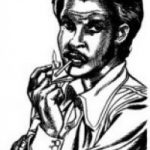Stein, Stephen K. 2021. Sadomasochism and the BDSM community in the United States: kinky people unite. New York : Routledge, Taylor & Francis Group
Stein’s first chapter, which attempts to describe the proto-BDSM culture of the early and mid twentieth century, is a necessarily scattershot collection of data points. Research any historical field long enough and the gaps in the record become clear. We know so little about the sadomasochistic subculture prior to the 1970s. There’s some data about the gay subset, precious little about straights, and practically nothing about lesbians. Stein had access to the Kinsey Institute, the Carter Johnson Leather Library, the NLA Archives and more, and even then he couldn’t shed any new light on American BDSM before 1970.
Stein treats the BDSM culture as a whole, whereas I think it is more accurate to describe it as three parallel but separate streams (gay, lesbian, and straight), each with their own economy, and culture, that occasionally influence each other.
Chapter 2 covers the founding of groups like The Eulenspeigel Society and Society of Janus in the early 1970s. This also provides a glimpse of what BDSM culture was like before the founding of TES.
[Janus Society founders Cynthia] Slater and [Larry] Olsen wanted to create an alternative to the Backdrop Club, a commercial BDSM operation, which organized itself as a private membership club to skirt prostitution and similar laws. […] Slater found the environment at Backdrop disheartening, both for management’s focus on profit and how it treated club members. Male members plaid “exorbitant registration fees” in exchange for “guaranteed sex, or whatever they came in for.” Those with submissive desires were treated poorly and expected to do whatever they “were told by just anybody who came in.” […] Jack Fritscher found women “pressured to put out” and “traded around like fuckable commodities on the New York Stock Exchange.” It was the antithesis of what [Pat] Bond, Slater and an emerging generation of BDSM activists envisioned.
[Pg.42-43]
If we take the Backdrop Club for what was typical for straight BDSM organizations until then, then groups like TES and Janus were a major evolutionary divergence. Only a few years after the Stonewall riots, they borrowed major ideas from gay liberation and feminism. Instead of something private for elites, BDSM became something public, and its practitioners had a stake in the struggle for liberation alongside gays and lesbians. Education, outreach and activism were parts of that.
In the 1970s and early 1980s, organizations loosely modelled on the examples of TES and SOJ formed across the USA. National or international organizations were the next logical step, but there were many different forces pulling the BDSM culture in different directions. At the founding of the National Leather Association, there was a lot of friction over if and how much it should include straights.
One of the meatiest parts of the book is Stein’s detailed account of the politicking around the attempts to create a national or international organization for kinky people. It goes in depth on the so-called Dallas Conference of February 12-14, 1988. Its 129 attendees included the leading figures in BDSM at the time, and came from a variety of sexualities, genders and cultures. The cultural divides almost tore the conference apart: gays versus lesbians versus straights, strict east-coast mens leather clubs versus loose and laid back pansexual west-coast groups, middle class versus working class, and GDIs (“god damned independents”) versus everybody else.
The proposed organization formed after the Dallas Conference, Safe Sane Consensual Adults (SSCA), never really came together, and had to merge with the pre-existing National Leather Association. Nonetheless, the Dallas Conference did make “Safe Sane and Consensual” the BDSM world’s unofficial motto, and turned the NLA into an officially pansexual organization.
Later chapters cover the BDSM community’s activism on various fronts, such as spreading safety information, distinguishing BDSM from domestic violence, lobbying to revise the Diagnostic and Statistical Manual, and hashing out the definition of “Safe, Sane and Consensual”. The last of those three terms was the most controversial. After the infamous “Consensual Non-Consensuality” panel at Living in Leather V in 1991 (nicknamed the “Death Workshop” by its critics), activists and educators argued back and forth over the exact definition of “consent” and whether it could ever be violated without becoming abuse.
The BDSM community had its own sources of internal and external friction, between flamboyant expression and respectable assimilation, between those who signed up for a political struggle and those who wanted to be left alone by the mainstream.
Something essential to BDSM would be lost … by making it too respectable. One could not simultaneously embrace BDSM’s outlaw mystique and present oneself as respectable. GMSMA and NLA leaders, though, hoped to do exactly that by shaping and normalizing BDSM– both its practice and its outward presentation– to win acceptance.
[Pg.147]
The later chapters depict a post-millennial BDSM culture that is a victim of its own success. The ubiquity of BDSM imagery and the availability of the Internet as a medium connection meant that people interested in kink could meet each other without the enculturation into safety and consent practices by formal organizations. E.g. the Oliver Jovanovic-Jamie Rzucek case in 1996. (This is really a perennial problem of the kink culture, the same one that groups like TES and SOJ were created the mitigate.) While direct police attacks on BDSM events faded away, pressure on BDSM content providers and social networks increased.
This superficial tolerance satisfied most sadomasochists’ needs, which posed a problem for BDSM organizations committed to winning greater tolerance.
[Pg.162]
The NLA declined from its decreasing membership and internal strife, and other second-generation kink organizations like GMSMA diminished or shut down. The Internet gobbled up BDSM print media like it did every other niche, and commercial social networks superseded the role of formal organizations. Fetlife, in particular, narrowed the range of kink that could be discussed while still refusing to allow naming of predators.
Some of these problems can ultimately be traced back to the commercialization of the BDSM subculture. The economic engines are controlled by people who put profit extraction ahead of education and socialization, and social and economic capital no longer circulates within the kinky world. Other changes are nobody’s responsibility but our own, such as the fragmentation into sub-scenes which barely connect with others, like the Japanese-style rope scene. Topics that were once taboo even amongst kinksters, like ageplay or raceplay, are now commonplace.
Ultimately, the BDSM community only comprises a small fraction of the people who practice BDSM.
This disparity proved a continuing frustration to BDSM activists, but they still managed to advance their agenda.
[Pg.187]
Stein is writing more for an academic than popular audience. His account of the growth of BDSM organizations in the 1970s and 1980s doesn’t say much about the personalities who founded them. (He misgenders Patrick Califia with female pronouns, even though Califia transitioned years before this book was published.) His approach is straightforward and descriptive, rather than sociological or anthropological theorizing.
There is no better resource when it comes to the book’s subject matter.




[…] Review: BDSM Community, by Stein […]
[…] Review: BDSM Community, by Stein […]
[…] Review: BDSM Community, by Stein […]
[…] Review: BDSM Community, by Stein […]
[…] The History section of the New Books Network podcast has an interview with Stephen K. Stein, author of Sadomasochism and the BDSM Community in the United States: Kinky People Unite (2021, Routledge). (Previously reviewed) […]
[…] Review: BDSM Community, by Stein […]